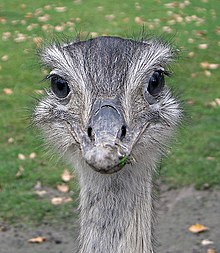Prisoner refugee

A captive refugee is an individual of an alien ( allochthonous ) animal species that has fled or been released from human care and can be considered to be free living.
Many captive refugees are birds, as individuals keep escaping , especially from ornamental poultry keeping. In this way, wood ducks and mandarin ducks have become permanent residents in Central Europe.
Captive refugees as neozoa
If captive refugees manage to reproduce in the wild for at least three generations , one speaks of neozoa . Similar to plants, the distribution of which has changed due to human intervention ( hemerochoria ), captive refugees as neozoa can expand (non- invasive ) or endanger (invasive) the biodiversity of a habitat , see also biological invasion .
One example is the mustangs , the wild horses of North America that have been known since the 16th century. Mustangs are not originally wild horses , but descendants of various domestic breeds . The Spanish conquistadors were the first to introduce horses to the New World (mostly Arabs and the domestic horse breeds native to Spain at the time), and later also other European immigrants. Many of these imported horses and their offspring escaped, feral and established stable populations as neozoa .
Wild populations repeatedly emerged in Germany after animals escaped from captivity in fur farming . One example is the raccoon from North America .
Captive refugees and wanderers
It is not always possible to properly identify refugees from prison. When determining the natural range or migration area of an animal species, wild exotic species can often cause considerable confusion. The cap saw from North America, for example, can occasionally end up in Europe during its migration to the summer or winter quarters. Since this duck bird species has often been kept as water fowl since the second half of the 20th century , animals found or observed in the wild are generally regarded as refugees from captivity. Only if the ringing of an individual proves something else, it is classified as a lost migratory bird ( Irrgast ).
literature
- Bernhard Kegel : The ant as a tramp. From biological invaders. Heyne, Munich 2002, ISBN 3-453-18439-4 .
- Tim Low: Feral Future. The untold story of Australia's exotic invaders. Penguin Books Australia, Ringwood 2001, ISBN 0-14-029825-8 .
- Ingo Kowarik: Biological Invasions. Neophytes and Neozoa in Central Europe. Ulmer, Stuttgart 2003, ISBN 3-8001-3924-3 .

